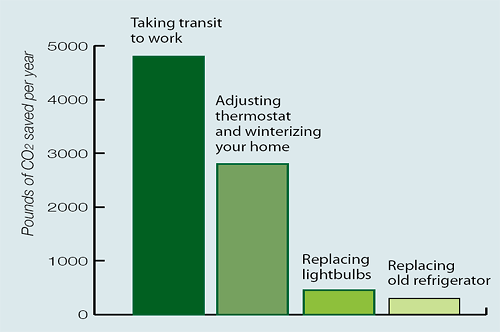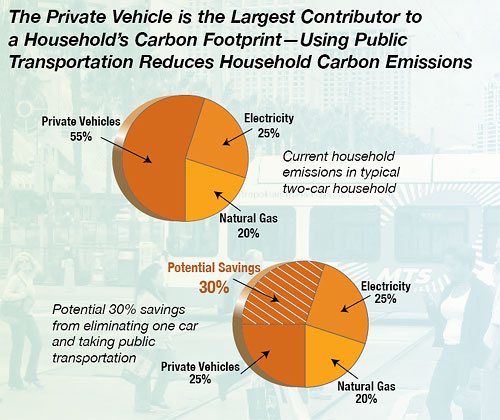The recent study Growing Cooler, coordinated by Smart Growth America and published by the Urban Land Institute, found that “Typically, Americans living in compact urban neighborhoods where cars are not the only transportation option drive a third fewer miles than those in automobile-oriented suburbs…”
On March 10, 2008, the American Public Transit Association released a closely related study that supplemented those findings. APTA’s study, The Broader Connection between Public Transportation, Energy Conservation and Greenhouse Gas Reduction, tackles the same topic from a different direction. It asks, How does the availability of transit affect land use, its energy efficiency, and its greenhouse gas emissions — not only for transit riders but for those who don’t ride transit?
The conclusion: Not only is the land use effect significant, it is major. Below the fold, some excerpts from the study and key findings.

Image credit: APTA
Excerpts from The Broader Connection
3. Key Findings
This study sought to estimate the effect of public transportation availability on household travel through the medium of land use, specifically on total vehicle miles traveled (VMT). We generally refer to this effect as a “secondary” effect, compared to the primary effect of substituting a mile traveled by automobile with a mile in a bus or train. For the secondary effects described here, lower household VMT is associated with public transportation availability via built environment characteristics in cities and suburbs across the U.S. …
3.2. Household Fuel Use and Public Transit Availability
… The model in the current paper confirms the hypothesis that public transportation availability has a significant secondary effect on VMT beyond the primary effect of using transit. The secondary effect is mainly generated through land use patterns. The magnitude of the secondary effect is approximately twice as large as the primary effect of actual public transit trips. This result suggests that public transit is a significant enabler of an efficient built environment. These effects are seen both through the relationship between availability of public transit and VMT and the same relationship mediated by land use patterns. … The net total effect of public transportation on energy savings is then estimated at 4.16 billion equivalent gallons of gasoline per year. (emphasis added)
The study draws on the National Household Travel Survey, which was conducted in 2001-2002. To put this finding in perspective, the United States consumed about 136 billion gallons of gasoline in 2002.
So public transit, which was responsible for 0.07 percent of all surface vehicle miles traveled (in the U.S. in 2002) reduced national energy use by the equivalent of three percent of total gasoline consumption.
3.3. Greenhouse Gas Implications
The estimated savings in petroleum use from public transportation can also be expressed in terms of greenhouse gas emissions. Carbon dioxide (CO2) is by far the most prevalent greenhouse gas emitted from motor vehicles. Each gallon of gasoline burned releases 8.9 kg of CO2. The total effects of public transit availability reduce CO2 emissions by 37 million metric tonnes annually.
To put this in perspective, in the U.S. in 2002, surface transportation emitted about 1,600 million metric tonnes of CO2. The 37 million metric ton reduction from public transit is equivalent to 2.3 percent of all surface transportation emissions.
Another way to put this into perspective: According to the authors, the 37 million metric ton CO2 reduction is equivalent to the electricity used by 4.9 million households.
What if we in the United States used transit at higher rates — like the Canadians or the Europeans? APTA’s earlier study, Conserving Energy and Preserving the Environment, provides the conversion factors. If we used public transit at the rate Canadians do, we would save about 260 million metric tons of CO2, equivalent to 16 percent of surface transportation emissions. If we used public transit at the rate Europeans do, we would save about 370 million metric tons of CO2, equivalent to 23 percent of surface transportation emissions.

Image credit: APTA
Resources
The Broader Connection between Public Transportation, Energy Conservation and Greenhouse Gas Reduction, by Linda Bailey, Patricia L. Mokhtarian, Ph.D. and Andrew Little, prepared by ICF International, Inc. with funding from Transit Cooperative Research Program of the Federal Transit Administration. March 2008.
Conserving Energy and Preserving the Environment by Robert J. Shapiro, Kevin A. Hassett and Frank S. Arnold. Commissioned by the American Public Transit Association. July 2002.
Public Transportation’s Contribution to Greenhouse Gas Reduction, by Todd Davis & Monica Hale. Prepared by Science Applications International Corporation (SAIC) with funding from Transit Cooperative Research Program of the Federal Transit Administration. September 2007.
APTA Online Publications and Surveys — Many additional sources with information about the benefits of public transit.

Very interesting and well researched, I am currently studying for my Part II in Architecture here in London. I am currently looking at future cities. I am proposing for my final year project a Sustainable Corridor Paradigm using the existing Motorway network (freeway in American), creating a linear series of towns connected by a mass transit system for people movement and basing the communities around a walkable neighborhoods…
Good information. I realize that our challenge is so very complex that we have to break it down into bite-sized portions. I also realize that we, unfortunately, need to convince folks that less cars and travel time can actually work for them in their everyday lives. However, the future of our communities ultimately is related to the health of our natural environment (not simply the built env.) and the most important reason for increasing walkability, development density, irrigation restrictions, etc. is to assure that there will be food, clean water, etc. for future generations. Today’s great place making must be done with the environmental limitations of to tommorrow in mind; not because the price of gas will increase and put a dent in our pocketbooks.
Ecotone Mark
Kissimmee – Saint Cloud
thank you I hope we continue to find out the right and safe way to reduce co2 in our environment
Interesting and informative webpage.
Sauid cities are fully dependent on the private car and face the challenges of sprawl in a harsh, water-thristy desert evironemnt.
Would love to follow.
Faisal